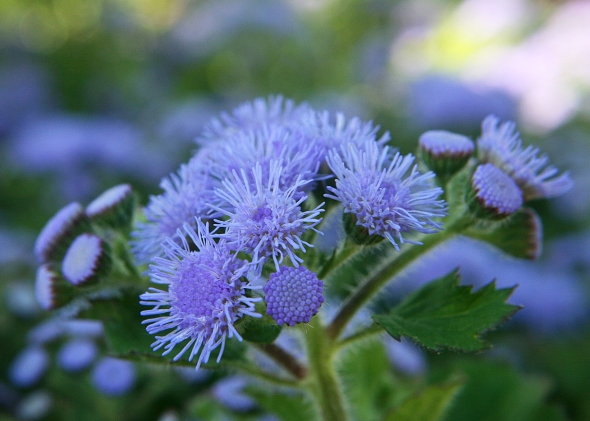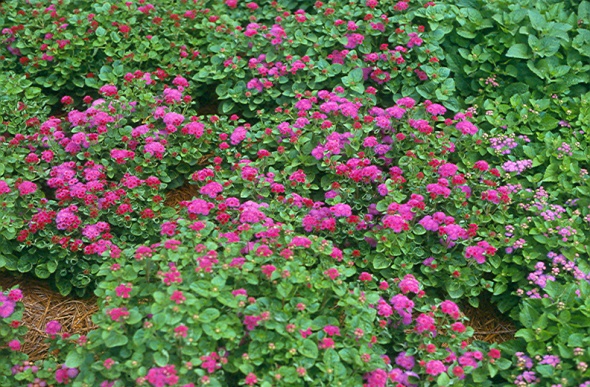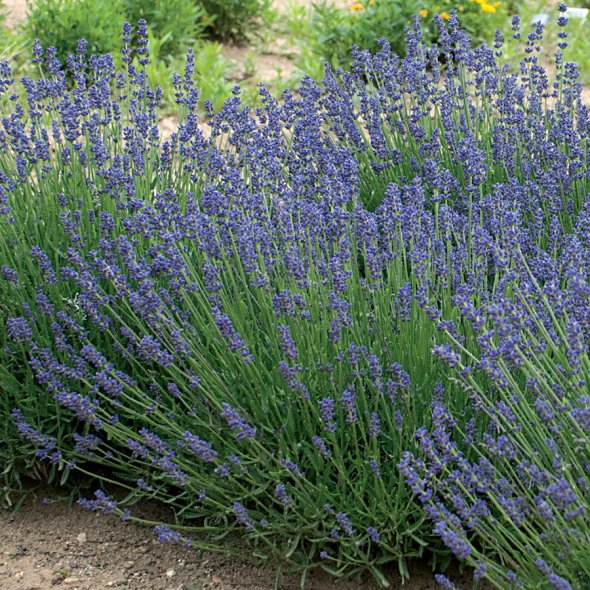Ageratum Plant Care Guide
Ageratum (əˈdʒɛrətəm/ A-gé-ra-tum),[1] (whiteweed in the USA), is a genus of 40[2] to 60 tropical and warm temperate flowering annuals and perennials from the family Asteraceae, tribe Eupatorieae. Most species are native to Central America and Mexico but four are native to the United States.[2]
They form tussocks or small hills. They grow to a height of 30 in. The opposite leaves are cordate or oval, hairy or tomentose. The margins are slightly toothed or serrate. The leaves form compact clusters.
The fluffy flowers are lavender-blue, pink, lilac, or white; and spread in small compound umbels. They give small, dry fruits.
Species
|
|
Segregate genera
The genus Paneroa consists of one species, Paneroa stachyofolia, native to Oaxaca, which was first described in Ageratum but which seems to be more closely related to Conoclinium and Fleischmannia.[9]
******************
Growing Ageratum Flower: How To Plant Ageratum
By Becca Badgett
Blue flowers for the garden are sometimes difficult to grow. Choices are limited and most require a full sun location. Ageratum plants, with fluffy blue flowers, add the desirable blue color to your garden, even if it is partially shaded. Caring for ageratums is simple and easy, particularly for the beginning gardener.
The ageratum flower most commonly found in the garden is a hybrid, growing in a petite and compact form. When you learn how to plant ageratum and grow it successfully, you will always have a blue flower option for the bed or border.
What Is Ageratum?
For those new to flower gardening, you may be wondering “what is ageratum and how is it cultivated?” Ageratum houstonianum, a native of Mexico, is among the most commonly planted ageratum varieties. Ageratums offer soft, round, fluffy flowers in various shades of blue, pink or white—with blue being most common.
Ageratum plants grow from seed or from small seedlings sometimes found in garden centers. More than 60 cultivars of the blue ageratum flower are available, often reaching only 6 to 8 inches when fully grown. The wild ageratum is a taller specimen that reseeds abundantly, but most available seeds of the ageratum will be from hybrid types.
Popular varieties of the ageratum flowers offer a range of blue colors and include the following cultivars:
- ‘Hawaii’ – This type has blooms of a royal blue. It flowers early and is one of the most long lasting of the species.
- ‘Blue Mink’ – This cultivar has flowers in a powder blue color and reaches 12 inches in height.
- ‘Blue Danube’ – A variety that reaches just 6 to 8 inches and features blooms in a medium blue shade.
Pink and white blooming cultivars are available as well, but tend to wither early and take on a worn, brown look.
How to Plant Ageratum
Ageratum plants may be started from seed when the soil has warmed outside. Cover seeds lightly, as seeds of ageratum plants need sunlight to germinate. For an early start to blooms of the ageratum flower, start seeds indoors eight to 10 weeks before planting in the spring garden.
Caring for Ageratums
An annual and sometimes perennial flower, the ageratum flower blooms from spring until fall when receiving proper care. Caring for ageratums includes regular watering until the plant is established. Use warm water to irrigate the plant for a bounty of blue blooms.
You should also deadhead spent blooms as needed to encourage more flowers.
Growing and caring for ageratums is simple. Stick with the popular blue blooms of the ageratum, deadhead as needed and enjoy the simple blue flower in your garden this year.
**************
See Also …
How to Grow Ageratum

Garden Myth ~ Citronella Geranium vs 5 Easy to Grow Mosquito-Repelling Plants that Work

The “citronella plant“ is a geranium plant marketed as “Pelargonium citrosum“, but according to the American Botanical Council, ” ‘Pelargonium citrosum’ is not a valid taxonomic designation.”[1] “Pelargonium citrosum” is marketed as a mosquito plant, or citrosa geranium in stores in the United States and Canada, but research indicates Pelargonium citrosum is ineffective against Aedes aegypti mosquitos.[2] “Not only was the plant ineffective at protecting humans against Aedes mosquito bites, the mosquitoes were seen landing and resting on the citrosa plant on a regular basis.”[1]
It is not related to true citronella. It contains some essential oil isolates that also occur in mosquito repellent plants. It is sold in this capacity .
It is claimed that P.citrosum may be a genetic bonding of the African geranium with genes from cymbopogon grass[1], but there is no scientific basis for this claim.
The citronella geranium is not to be confused with other mosquito plants, nor with the grass also known as citronella. Also, citronella oil does not come from P.citrosum.
Not to be confused with Citronella mucronata (Chilean Citronella), which is a tree.
***************
5 Easy to Grow Mosquito-Repelling Plants @ earth easy.com
As the outdoor season approaches, many homeowners and outdoor enthusiasts look for ways to control mosquitoes. With all the publicity about the West Nile virus, mosquito repelling products are gaining in popularity. But many commercial insect repellents contain from 5% to 25% DEET. There are concerns about the potential toxic effects of DEET, especially when used by children. Children who absorb high amounts of DEET through insect repellents have developed seizures, slurred speech, hypotension and bradycardia.
There are new DEET-free mosquito repellents on the market today which offer some relief to those venturing outdoors in mosquito season. But there are also certain plants which are easy to grow and will have some effect in repelling mosquitoes from areas of your home and garden.
Here are five of the most effective mosquito repelling plants which are easy to grow in most regions of the US:
1. Citronella
Citronella is the most common natural ingredient used in formulating mosquito repellents. The distinctive citronella aroma is a strong smell which masks other attractants to mosquitoes, making it harder for them to find you. Although citronella is used in many forms, such as scented candles, torches and citronella ‘scented’ plants, the living plant is more effective because it has a stronger smell.
Citronella is a perennial ‘clumping’ grass which grows to a height of 5 – 6 feet. It can be grown directly in the ground in climate zones where frost does not occur. If grown in the garden or near the patio, it should be planted in the ‘background’, behind small decorative flowers and shrubs. In northern climate zones citronella can be grown in a large pot or planter, ideally with casters, so it can be rolled indoors during winter.
Gardening centers usually sell citronella as small plants in pots, ready to transplant to a larger pot or into raised garden beds on the ground. Once established, new plants can be propagated in early spring by splitting large clumps into smaller sections and replanting the new ‘starts’ in pots or other areas of the garden. Citronella plants are considered low maintenance, like most grasses, and they do best in full sun and well-drained locations. Periodic applications of nitrogen-rich fertilizers will ensure vigorous growth, but this treatment only needs to be applied once a year, preferably in early spring.
When purchasing citronella, look for the true varieties, Cybopogon nardus or Citronella winterianus. Other plants may be sold as ‘citronella scented’, but these do not have the mosquito repelling qualities of true citronella.
2. Horsemint

Also known as Beebalm, Horsemint is an adaptable perennial plant which repels mosquitoes much the same as citronella. It gives off a strong incense-like odor which confuses mosquitoes by masking the smell of its usual hosts.
Horsemint is a fast growing, shade-tolerant and drought-resistant plant which reaches a height and width of 2 – 3 feet. It does well in dry, sandy soil and can tolerate salty conditions, which is why it is often found in coastal and beach areas. Horsemint seeds can be sown indoors in trays for later transplanting, or sown directly into the ground in late summer in colder climate zones. Midwest and Eastern growing zones are favoured for growing horsemint.
Mature horsemint plants can be divided in spring and fall by dividing into small sections and transplanting into permanent locations. Horsemint can also be planted in pots for moving indoors in cold climate zones.
Horsemint leaves can be dried and used to make herbal tea. Its flowers will also attract bees and butterflies to your garden.
3. Marigolds
Commonly grown as ornamental border plants, marigolds are hardy annual plants which have a distinctive smell which mosquitoes, and some gardeners, find particularly offensive. Marigolds contain Pyrethrum, a compound used in many insect repellents.
Marigolds prefer full sunlight and reasonably fertile soil. Although marigolds can be planted from seed, starter plants are inexpensive and readily available at most garden centers. Although an annual, marigold will often reseed itself in favourable conditions, or the gardener can easily collect seeds for future germination. Established plants will need to be thinned, and flowers should be dead-headed to promote additional blooms.
Potted marigolds can be positioned near entrances to your home and any common mosquito entry points, such as open windows. The smell may deter mosquitoes from going past this barrier. While marigolds can be used as border plants around the patio, we do not advise putting marigolds on the patio table since the bright blooms may attract wasps.
Besides repelling mosquitoes, marigolds repel insects which prey on tomato plants, so you may want to plant a few marigolds in your tomato bed for added protection.
4. Ageratum

Also known as Flossflowers, Ageratum emits a smell which mosquitos find particularly offensive. Ageratum secretes coumarin, which is widely used in commercial mosquito repellents.
Ageratum is a low-lying annual ornamental plant which reaches heights of 8 – 18”, and is easily recognized by its blue flowers, although there are varieties with pink, white and violet blooms. This plant will thrive in full or partial sun and does not require rich soil. It is often displayed in rock gardens where low-lying plants are favoured.
Although the leaves of Ageratum can be crushed to increase the emitted odor, it is not advisable to rub the crushed leaves directly on the skin.
5. Catnip

Catnip is a natural mosquito repellent. In August 2010, entomologists at Iowa State University reported to the American Chemical Society that catnip is ten times more effective than DEET, the chemical found in most commercial insect repellents. According to Iowa State researcher Chris Peterson, the reason for its effectiveness is still unknown. “It might simply be acting as an irritant or they don’t like the smell. But nobody really knows why insect repellents work.”
In the laboratory, Peterson put groups of 20 mosquitoes in a two-foot glass tube, half of which was treated with nepetalactone, a biologically active characteristic constituent of catnip. After 10 minutes, only an average of 20 percent – about four mosquitoes – remained on the side of the tube treated with a high dose (1.0%) of the oil. In the low dose test (0.1%) an average of 25% – five mosquitoes – stayed on the treated side. When the same tests were conducted using DEET (diethyl-meta-toluamide), approximately 40 to 45% – eight to nine mosquitoes – remained on the treated side. A ten-fold higher concentration of DEET was required to obtain results similar to those of the Catnip.
Catnip, Nepeta cateria, is very easy to grow. This perennial herb is related to mint, and grows readily both as a weed and a commercially cultivated plant in most areas of the US.
While catnip will repel mosquitoes in close proximity to the plant, some people apply crushed catnip leaves or catnip oil for more robust protection. Bear in mind, however, that cats will respond to you similarly as they would respond to the plant itself. Cat owners may want to choose an alternative plant for repelling mosquitoes.
While the plants mentioned in this article have been shown to have mosquito-repelling properties, there are environmental variables that can mitigate their effectiveness. A breeze may direct odors in the opposite direction if advancing mosquitoes, reducing the plant’s effectiveness. Recommend :
Wellness Mama Essential Oil Bug Spray

Wellness Mama Bug Spray Ingredients:
- Essential oils: choose from Citronella, Clove, Lemongrass, Rosemary, Tea Tree, Cajeput, Eucalyptus, Cedar, Catnip, Lavender, Mint
- Natural Witch Hazel
- Distilled or boiled Water
- Vegetable glycerin (optional)
How to Make Homemade Bug Spray:
- Fill spray bottle (I used 8 ounce) 1/2 full with distilled or boiled water
- Add witch hazel to fill almost to the top
- Add 1/2 tsp vegetable glycerin if using
- Add 30-50 drops of essential oils to desired scent. The more oils you use, the stronger the spray will be. My personal favorite mix is: Rosemary, Clove, Cajeput, Lavender, Cinnamon and Eucalyptus… it works great and smells good too!
Make Bug Spray From Dried or Fresh Herbs
Fresh or Dried Herbs Bug Spray Ingredients:
- Distilled water
- witch hazel or rubbing alcohol
- dried herbs: peppermint, spearmint, citronella, lemongrass, catnip, lavender, etc. I recommend using at least one herb from the mint family.
How to Make Bug Spray From Fresh or Dried Herbs:
- Boil 1 cup of water and add 3-4 TBSP of dried herbs total in any combination from the above. I use 1 TBSP each of peppermint, spearmint, catnip and lavender, and also throw in a couple of dried cloves.
- Mix well, cover and let cool (covering is important to keep the volatile oils in!)
- Strain herbs out and mix water with 1 cup of witch hazel or rubbing alcohol. Store in a spray bottle in a cool place (fridge is great because then its nice and cool!)
- Use as needed. Added bonus: it smells great and is very refreshing to the skin!
Super Strong Insect Repellent Recipe
Fair warning: this stuff stinks when it is wet, though the smell disappears as it dries. It works incredibly well though, and this is the one I use when I’m going to be in the woods or in tick infested areas. It is based on a recipe that was supposedly used by thieves during the Black Plague to keep from getting sick. They used it internally and externally to avoid catching the disease and to keep the flies and other pests away. According to legend, it worked and they survived… but it definitely makes a great insect repellent these days! Its also very inexpensive to make and you probably already have the ingredients in your kitchen!
Vinegar of the Four Thieves Insect Repellent Ingredients:

- 1 32 ounce bottle of Apple Cider Vinegar
- 2 TBSP each of dried Sage, Rosemary, Lavender, Thyme and Mint
- At least quart size glass jar with airtight lid
How to Make the Vinegar of the Four Thieves Insect Repellent:
- Put the vinegar and dried herbs into large glass jar.
- Seal tightly and store on counter or place you will see it daily. Shake well each day for 2-3 weeks.
- After 2-3 weeks, strain the herbs out and store in spray bottles or tincture bottles, preferably in fridge.
- To use on skin, dilute to half with water in a spray bottle and use as needed.
- Use whenever you need serious bug control!
[Note: This mixture is very strong and has antiviral and antibacterial properties. It can also be used as a tincture for any illness. For adults, dose is 1 TBSP in water several times a day,for kids over 2, dose is 1 tsp in water several times a day.]
Other Simple Insect Repelling Ideas:
- Add vanilla extract to either of the above recipes, or just rub on the skin. You can also mix vanilla with witch hazel and water for a spray version.
- Rub lavender flowers or lavender oil on your skin, especially on hot parts of body (neck, underarms, behind ears, etc) to repel insects.
- Rub fresh or dried leaves of anything in the mint family all over skin to repel insects (peppermint, spearmint, catnip, pennyroyal, etc or citronella, lemongrass, etc) Basil is also said to repel mosquitoes and I’ve used fresh basil leaves in the garden with great success before!















Recent Comments